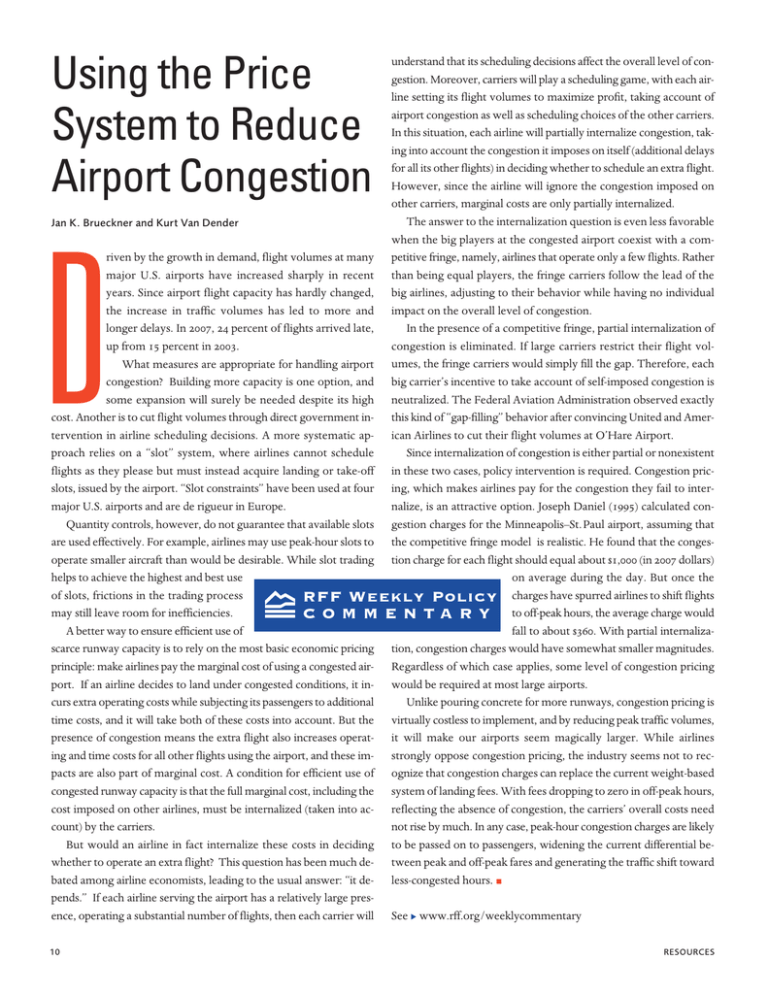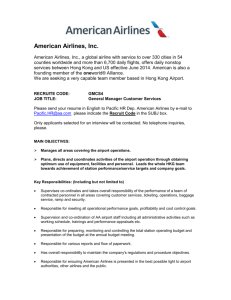understand that its scheduling decisions affect the overall level of... gestion. Moreover, carriers will play a scheduling game, with each...
advertisement

Using the Price System to Reduce Airport Congestion understand that its scheduling decisions affect the overall level of congestion. Moreover, carriers will play a scheduling game, with each airline setting its flight volumes to maximize profit, taking account of airport congestion as well as scheduling choices of the other carriers. In this situation, each airline will partially internalize congestion, taking into account the congestion it imposes on itself (additional delays for all its other flights) in deciding whether to schedule an extra flight. However, since the airline will ignore the congestion imposed on other carriers, marginal costs are only partially internalized. The answer to the internalization question is even less favorable Jan K. Brueckner and Kurt Van Dender when the big players at the congested airport coexist with a comriven by the growth in demand, flight volumes at many petitive fringe, namely, airlines that operate only a few flights. Rather major U.S. airports have increased sharply in recent than being equal players, the fringe carriers follow the lead of the years. Since airport flight capacity has hardly changed, big airlines, adjusting to their behavior while having no individual the increase in traffic volumes has led to more and impact on the overall level of congestion. In the presence of a competitive fringe, partial internalization of longer delays. In 2007, 24 percent of flights arrived late, congestion is eliminated. If large carriers restrict their flight volup from 15 percent in 2003. What measures are appropriate for handling airport umes, the fringe carriers would simply fill the gap. Therefore, each congestion? Building more capacity is one option, and big carrier’s incentive to take account of self-imposed congestion is some expansion will surely be needed despite its high neutralized. The Federal Aviation Administration observed exactly cost. Another is to cut flight volumes through direct government in- this kind of “gap-filling” behavior after convincing United and Amertervention in airline scheduling decisions. A more systematic ap- ican Airlines to cut their flight volumes at O’Hare Airport. Since internalization of congestion is either partial or nonexistent proach relies on a “slot” system, where airlines cannot schedule flights as they please but must instead acquire landing or take-off in these two cases, policy intervention is required. Congestion pricslots, issued by the airport. “Slot constraints” have been used at four ing, which makes airlines pay for the congestion they fail to internalize, is an attractive option. Joseph Daniel (1995) calculated conmajor U.S. airports and are de rigueur in Europe. Quantity controls, however, do not guarantee that available slots gestion charges for the Minneapolis–St.Paul airport, assuming that are used effectively. For example, airlines may use peak-hour slots to the competitive fringe model is realistic. He found that the congesoperate smaller aircraft than would be desirable. While slot trading tion charge for each flight should equal about $1,000 (in 2007 dollars) on average during the day. But once the helps to achieve the highest and best use of slots, frictions in the trading process RFF Weekly Policy charges have spurred airlines to shift flights may still leave room for inefficiencies. C O M M E N T A R Y to off-peak hours, the average charge would fall to about $360. With partial internalizaA better way to ensure efficient use of scarce runway capacity is to rely on the most basic economic pricing tion, congestion charges would have somewhat smaller magnitudes. principle: make airlines pay the marginal cost of using a congested air- Regardless of which case applies, some level of congestion pricing port. If an airline decides to land under congested conditions, it in- would be required at most large airports. Unlike pouring concrete for more runways, congestion pricing is curs extra operating costs while subjecting its passengers to additional time costs, and it will take both of these costs into account. But the virtually costless to implement, and by reducing peak traffic volumes, presence of congestion means the extra flight also increases operat- it will make our airports seem magically larger. While airlines ing and time costs for all other flights using the airport, and these im- strongly oppose congestion pricing, the industry seems not to recpacts are also part of marginal cost. A condition for efficient use of ognize that congestion charges can replace the current weight-based congested runway capacity is that the full marginal cost, including the system of landing fees. With fees dropping to zero in off-peak hours, cost imposed on other airlines, must be internalized (taken into ac- reflecting the absence of congestion, the carriers’ overall costs need not rise by much. In any case, peak-hour congestion charges are likely count) by the carriers. But would an airline in fact internalize these costs in deciding to be passed on to passengers, widening the current differential bewhether to operate an extra flight? This question has been much de- tween peak and off-peak fares and generating the traffic shift toward bated among airline economists, leading to the usual answer: “it de- less-congested hours. ∫ pends.” If each airline serving the airport has a relatively large presence, operating a substantial number of flights, then each carrier will See † www.rff.org/weeklycommentary DI 10 RESOURCES



